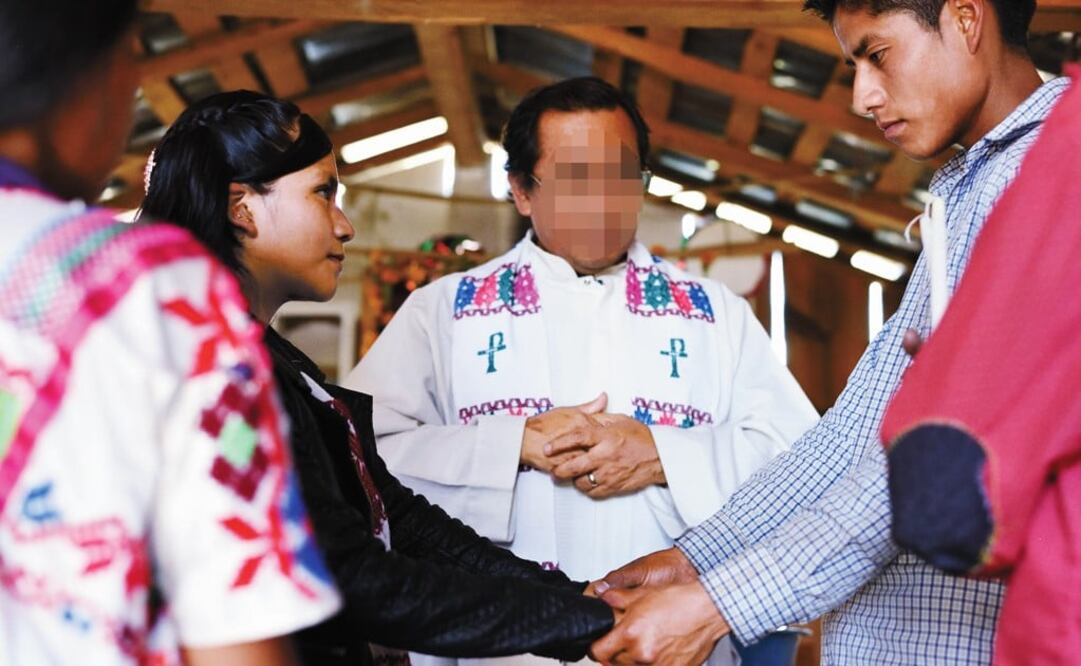Más Información

Senador del PT propone crear televisión, radio y periódico de la 4T; debemos hacer frente a medios de derecha, dice

César Duarte comparece ante jueza en penal del Altiplano; buscan vincularlo por presunto lavado de dinero

¿Qué es el Tratado de Aguas de 1944 entre México y EU por el que Trump amaga con imponer aranceles?; te explicamos

Gobernador de Michoacán se reúne con Sheinbaum en Palacio Nacional; acude también gabinete de Seguridad

Posponen en el Senado discusión y votación de reforma para crear la figura de “jueces sin rostro”; se discutirá en febrero

VIDEO Hallan a pareja sin vida en colonia Lindavista; una de las víctimas era abogado que litigó temas de despojos en Ecatepec
Alicia
can't remember the date when her family forced her to live with a man she didn't know but what she does remember is she was just a girl . Back then, the man paid MXN $150 for her, she calculates that now that would be worth MXN $1.50. That “ marriage ” last two and a half years.
She was mistreated by her in-laws, the aggressions started after the first year of “ marriage ”; first, it was because she visited her ill father but then the real reason came to light: she couldn't get pregnant . One day, her father-in-law beat her with a stick, told her to leave, and said that if she couldn't get pregnant she wasn't useful to the family .
Alicia
then returned home and her parents tried to convince her to return with her “ husband .” They told her that she had been sold, that she belonged to them. Alicia refused and her own family shunned her. She lived with her aunt for several years until she was allowed to return home.
Now Alicia is 74 years old, she has eight children and several grandchildren. In time she understood why she couldn't get pregnant back then: she didn't even menstruate , she was too young . The next time she was forced to live with a stranger no one paid money, she was kidnapped .
Stolen innocence
In La Montaña , in the state of Guerrero , no one is surprised by their sinister “tradition,” no one is surprised that girls are being robbed of their childhood and that they become adults and mothers overnight. They call it a dowry .
The dowry is an ancestral tradition in some Indigenous communities , although now it only is an economic transaction.
It used to be an offering made by a family to another to wish happiness to the new couple . They offered flowers, bread, beer, animals, and money ; there were no established tariffs. It was a way to thank the woman's family for bringing up their daughter and to calm their sadness after letting one of their girls go. But things have changed, families carry out intense negotiations . Prices range between MXN $40,000, MXN $80,000 , and MXN $150,000, although in some cases prices are under MXN $1,000.
According to “ tradition ” the value of the girl is established after analyzing three aspects: the age , the younger the girl, the more she is worth, they are forced into marriage as young as 12; their behavior , if she had a boyfriend , the price will be lower; education , the more educated the girl is, the lower the price will be.
In the last five years, Neil Arias, a lawyer from the Human Rights Center in La Montaña Tlachinolla n, has documented 50 cases of girls who were the victims of human trafficking , at least 10 per year. She explains that it is such a deep-rooted tradition at La Montaña that trying to prevent it is almost impossible. The lawyer revealed that she doesn't know of a Catholic priest who has refused to officiate the wedding of a girl. “There are entire towns where, if that happens, a priest will never enter the community again. And many priests do the math and prefer to keep on officiating the marriages,” she explains.
The city councils don't lift a finger, she says, to prevent girls from being sold and when a woman wants to leave the marriage , they always side with those who paid money . But there is also a structural issue: poverty . With the sale of girls, families get rid of another mouth to feed.
Neil Arias
affirms that poverty goes hand in hand with the lack of schools, hospitals, and roads. With human trafficking , we are facing a grim scenario: the poor buying the poor .
The kidnap
One year after Alicia returned to her parent's home, Alicia encountered the young man she was in love with again. Since he had no money for the dowry , they had a secret romance. She got pregnant and her first child was born and although the town and her family shunned her, she resisted for four years.
During that time, her aunt insisted that she should marry one of her nephews, Ignacio . She tried to convince her by telling her that he was a widower and had a lot of money and that he would treat her right. Alicia refused.
A few days later, the family who was going to pay for Alicia to become their son's “ wife ” visited her parent's home, her parents agreed instantly. A night before the wedding , when her parents and brothers weren't home, her aunt arrived along with five armed men . She woke Alica up and told her to pack her belongings because she had to leave with Ignacio . “Accept because if you don't they are going to kill us all,” she told Alicia. Alicia carried her son, grabbed a couple of things, and left without knowing which of the five men was going to be her “ husband .”
Slavery
Two months after the kidnap , Alicia's parents found Ignacio's home. Nevertheless, they weren't able to see her. Alicia was told that her parents were really angry because she left with another man when they had already closed a deal . Ignacio's parents tried to give them an offering but they refused.
The fact that her parents found Alicia marked the beginning of her doom . Ignacio started to mistreat her, beat her. Anything was used as an excuse to attack her. Alicia remembers that one day, when she went to get wood, her skirt got stuck on a tree and it ripped.
When she arrived home, Ignacio asked her which man had ripped her skirt, she beat her with sticks until they broke. He was always jealous and hit her all the time.
One time, Alicia managed to e scape and went to her parents' home but they told her to leave. They accused her of having left on her own, they didn't believe she was kidnapped by Ignacio. She never tried to escape again. But her father-in-law now protected her because he never agreed to the kidnap and the mistreatment .
Alicia lived with Ignacio for 25 years
, they had 8 children. It was a tortuous lif e, with mistreatment and forced work.
Most of the times families buy wives so that their sons don't work the fields by themselves. To pay the dowry , they get in debt, they sell their animals, or they work for a long time. In the end, they know it is an “ investment ” because the woman will work to repay the debt .
– Why did you endure so much?
– For my children – says Alicia
– Did you ever feel happy ?
– Never, on the contrary, he only mistreated me and made my children feel hunger
Tradition as an excuse
The sale of girls is a practice that hasn't been typified as human trafficking , said Neil Arias . It is complicated because of the anthropological aspect, they argue and claim that it is a tradition and part of their habits and customs although it actually is human trafficking.
Out of all the cases she has monitored, she has only been able to file charges for human trafficking in one case.
It is the case of three girls, which took place in 2009 . This is the story, according to the dossier. The three girls were in junior high school, they were on vacations and one of their aunts told them that if they wanted to make MXN $5,000 , they would have to leave with her, she promised they would come back, and asked her to keep it a secret . Nevertheless, one of them told their parents. She kidnapped the girls and took them to Teocuitlapa , in Quechultenango , where she handed them over to a man who then took them to Chilapa and bought them new clothes and shoes.
The man then took them to Cuba Libre , a community located in Xalpatlahuac , where he tried to sell two of them, he asked MXN $50,000 for each of the girls. In the end, he was paid MXN $40,000 : one was to be married to a boy and one to an older man.
The other girl, Flor , was taken to Tlapa , where he raped her and then tried to sell her, claiming she was his daughter. She was “bought” by a man who said he was looking for a girl for his son who was deaf-mute . Flor didn't realize she was sold, she found out weeks later, when she asked for her salary , thinking that she was working. The “ buyer ” was also surprised when he found out that she wasn't the daughter of the man who sold her. The girl lived with the family for eight months, she wasn't sexually abused by the son but she worked without pay.
The fathers of the three girls looked for them, filed a lawsuit and an arrest warrant was issued against the man who sold them. When he was arrested he revealed their location. During the legal process , those who paid for the girls tried to defend themselves by saying that they had paid for a dowry but in the end, they were sentenced to jail because there were lies involved. It was later revealed that the aunt kidnapped the girls because she had been threatened . Her son had been kidnapped and in order to free him, she has to convince the girls to leave.
gm
Noticias según tus intereses
[Publicidad]
[Publicidad]









